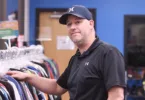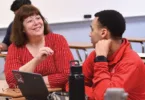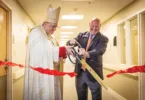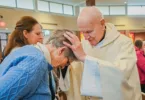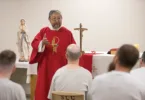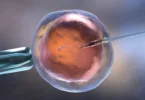by Joe Bollig
joe.bollig@theleaven.org
LENEXA — You know you should read the Bible, and you want to read the Bible, and you try to read the Bible.
And you fail. Back to the shelf your Bible goes to gather dust.
It’s not your fault, said Jeff Cavins, a Catholic author, broadcaster, teacher, and creator of the “Great Adventure Bible Study.”
Cavins detailed his journey from Protestant pastor to Catholic convert at St. James Academy in Lenexa on Nov. 1, and gave a Bible-in-a-Day seminar on Nov. 2.
Approximately 650 people attended his Friday talk and 550 attended the seminar on Saturday.
Reading the Bible is not as easy as one might think, and here is why.
What typically happens is a person makes a strong resolution to finally become a faithful Bible reader.
“They go out and buy a brand-new Bible, because the old one doesn’t work,” he said. “A new Bible with gold edges, very pretty. And they wait until Jan. 1 to start.”
So the individual has a shiny new Bible, a nice moleskin notebook and an expensive pen “worthy of [your] thoughts — a pen that will be a friend for life.”
On Jan. 1, they begin to read, so excited, at Chapter 1 of Genesis and march on through all the stories of creation, Adam and Eve, Cain and Abel, Noah, and so on.
So far, so good.
“All of a sudden, in March, you quit,” said Cavins. “Why? You’re in Leviticus — Leviticus! And you’re reading about menstrual cycles, and scabs on men’s legs, and offerings, and flour, and this and this and that.”
The individual quits — because they’ve lost the narrative.
In his seminar, Cavins used his Bible Timeline chart, workbook, bracelet and other materials to demonstrate how Catholics can learn the narrative of their faith while growing to more fully appreciate the Bible.
Any adult Catholic who grew up in the church, said Cavins, already possesses a “great big pile” of Catholicism that they don’t know how to organize and access.
“The problem most Catholics have is that they can’t put all of this together and tell a story,” said Cavins. “They can’t put all of this together and give an explanation to anyone about why they are Catholic and what it means to be Catholic. . . . The reason why they can’t tell their story is because they don’t understand the way all things Catholic fit together.”
Thankfully, the church has given Catholics a tremendous tool to make sense out of that pile — and also explains how the Bible fits into that pile: the Catechism of the Catholic Church.
“Every family should have one,” said Cavins. “The catechism takes that pile and systematizes it. It puts it into a systematic presentation.”
The catechism is divided into four pillars: the creed, the sacraments and liturgy, life in Christ, and prayer.
The first tells the story (otherwise known as salvation history), the second tells how to get into the story, the third tells how to live it out (your personal script), and the fourth is about having a relationship with God.
“The Bible is the first pillar,” said Cavins. “If you don’t know the story of salvation history, you’ll be compromised on your understanding of the sacraments and liturgy. Why? Sacraments and liturgy spring from the story.
You’ll be compromised on knowing Jesus Christ. Why? Ignorance of Scripture is ignorance of Christ. You’ll be compromised in prayer, because the Bible . . . teaches us how to pray.”
For the remainder of the day, Cavins led seminar participants through the Bible, using his workbook and color- coded foldout chart as his guide. He began with the Book of Genesis and concluded with the messianic fulfillment as recorded in the Gospel of Luke and the Acts of the Apostles.
“I was very impressed, and I’m so glad I’m here,” said Debra Niesen, a seminar attendee from Holy Trinity Parish in Lenexa. “He did a great job of laying everything out logically to help people grasp how to read the Bible and understand it.”
She reads the Bible, but is sometimes intimidated by the parts she doesn’t understand.
“This timeline will definitely help to make it more of a story so you can read it as a story and understand it so much better.”
Joanna Crawford, from St. Matthew Parish in Topeka, agreed.
“Prior [to becoming a Catholic] I knew the basic stories and ideas, but I never read the Bible,” said Crawford, a convert to the Catholic faith in 2009.
“Through what he’s done, I get it.”
“Our parish right now is doing a Catholic Scripture study, and it’s way over my head,” she continued. “I don’t get it. . . . We’re doing [the Letter to the] Hebrews, and it’s really hard for me, being new and not getting the correlations.
“That’s why I was on board coming here. Cavins puts it in terms I understand and it makes me want to learn so much more.”
“I’m that person now,” added Crawford, “who’s the eager beaver and wants to read the whole thing, learn everything I can, and become as knowledgeable as him. And I know he has great tools to teach us.”
For more information about Cavins’ Bible study materials, go online.

